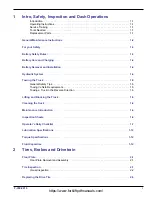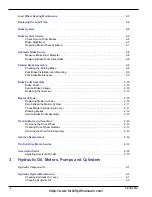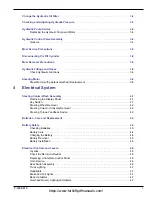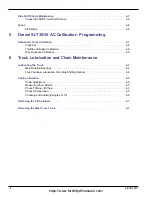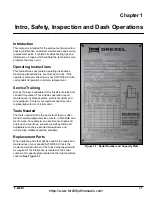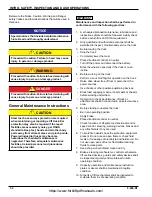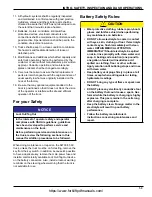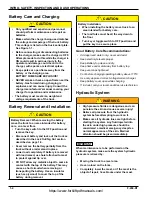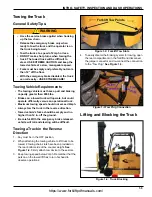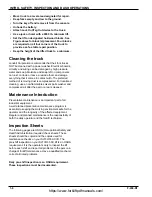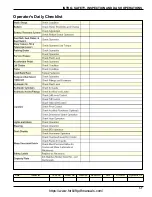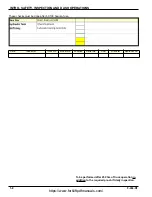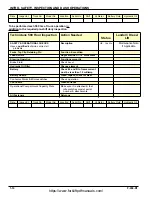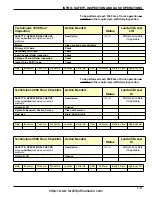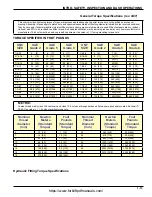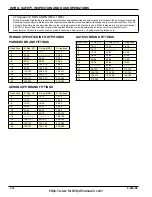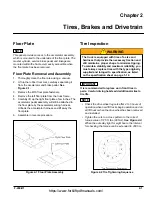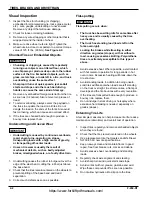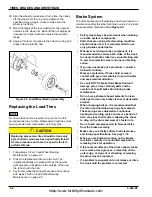
INTRO, SAFETY, INSPECTION AND DASH OPERATIONS
1-3
11. All hydraulic systems shall be regularly inspected
and maintained in conformance with good practice.
Cylinders, valves and other similar parts shall be
checked to assure that “drift” has not developed to an
the extent that it would create a hazard.
12. Batteries, motors, controllers, limit switches,
protective devices, electrical conductors and
connections shall be maintained in conformance with
good practice. Special attention shall be paid to the
condition of electrical insulation.
13. Trucks shall be kept in a clean condition to minimize
fire hazards and facilitate detection of loose or
defective parts.
14. Modifications and additions which affect capacity and
safe truck operation shall not be performed by the
customer or user without manufacturers prior written
approval. Capacity, operation and maintenance
plates or decals shall be changed accordingly.
15. Care must be taken to assure that all replacement
parts are interchangeable with the original and are of
equal quality to what was originally installed on the
truck at the factory.
16. Be sure that any optional equipment added to the
truck is positioned so that it does not block the vision
of the operator or interfere with safe and efficient
operation of the truck.
For your Safety
NOTICE
When doing maintenance or repair on the SLT30/35 AC
truck, unless the truck must be on for testing, remove the
key from the key switch. In addition, because it’s possible
to have a duplicate key, remove the main power fuse and
install a commercially available Lock Out/Tag Out device
on the battery connectors. Also, install a lockout warning
reminder on the steering wheel warning that the truck is
not available for use.
Battery Safety Rules:
CAUTION
Lock Out/Tag Out
In the interest of operator safety and operator
compliance with OSHA regulations, guidelines
have been developed to perform service and
maintenance on the truck.
Before performing service and maintenance on
the truck, review the following sections in this
manual for addition procedures to be followed.
• Wear protective clothing, rubber apron, boots
gloves and full-face shield when performing
any maintenance on batteries.
• DO NOT allow electrolyte to come in contact
with eyes, skin, clothing or floor. If electrolyte
contacts eyes, flush immediately with clean
water. OBTAIN MEDICAL ATTENTION
IMMEDIATELY! Should electrolyte be spilled
on skin, rinse promptly with clean water and
soap. A baking soda solution (one pound to
one gallon of water) will neutralize acid
spilled on clothing, floor or other surfaces.
Apply solution until bubbling stops and rinse
with clean water.
• Keep battery vent plugs firmly in place at all
times, except when adding water or taking
hydrometer readings.
• DO NOT bring any type of flame or spark near
the battery.
• DO NOT place any electrically conductive tool
on the battery that could cause a spark. Gas
formed while the battery is charging is highly
explosive. This gas remains in the cells long
after charging is complete.
• Keep the battery clean. Foreign matter in the
electrolyte will result in poor battery
performance.
• Follow the battery manufacturer’s
instructions concerning maintenance and
repair.
https://www.forkliftpdfmanuals.com/



